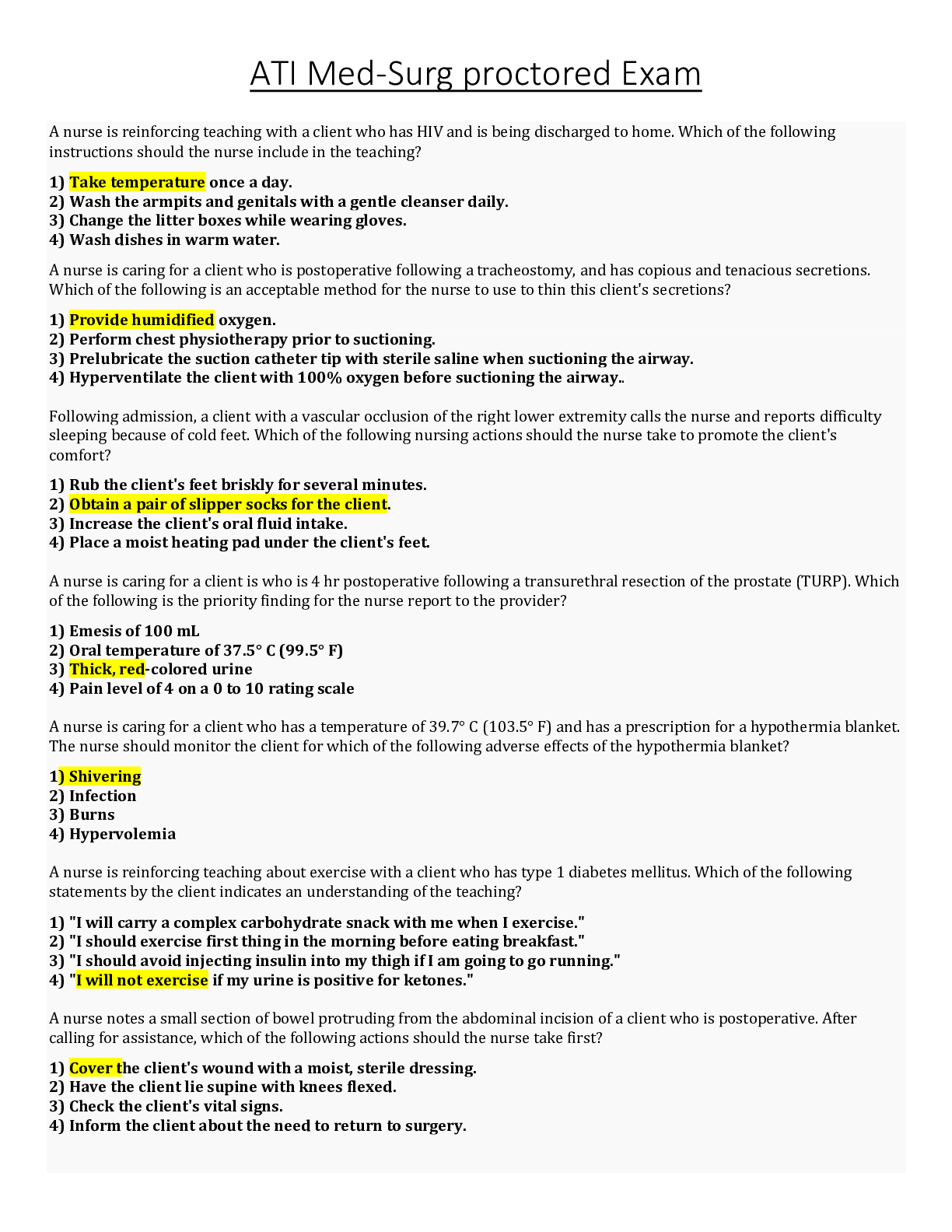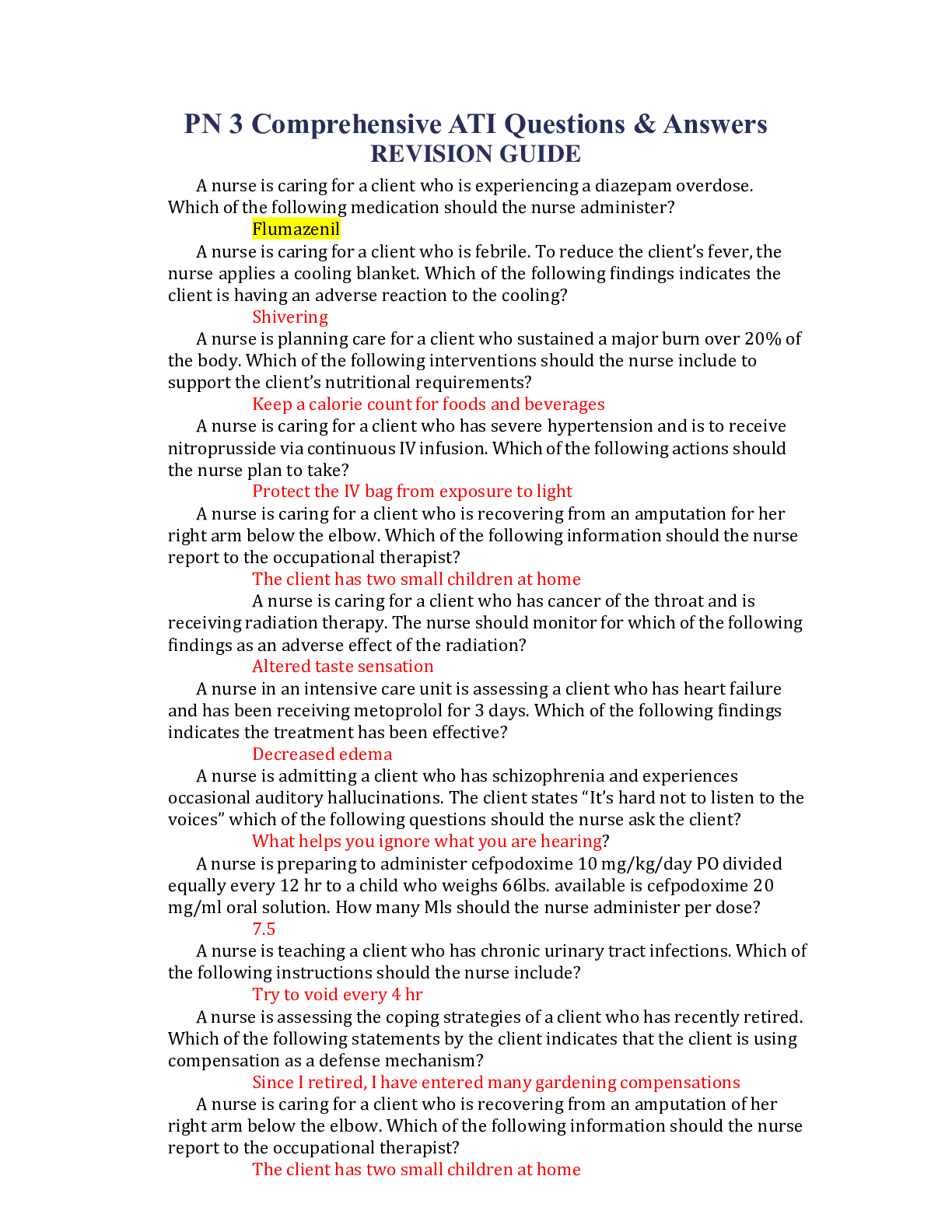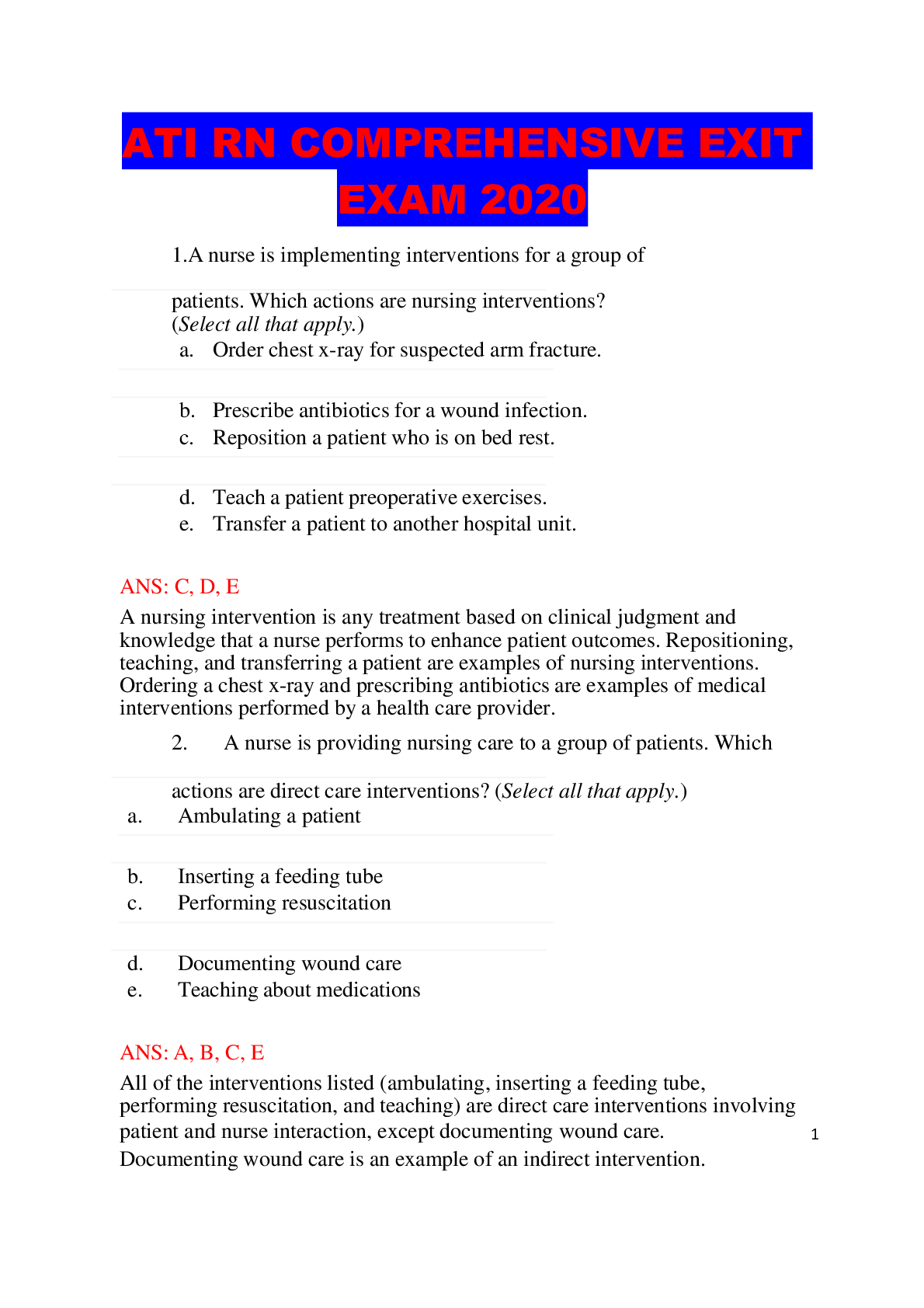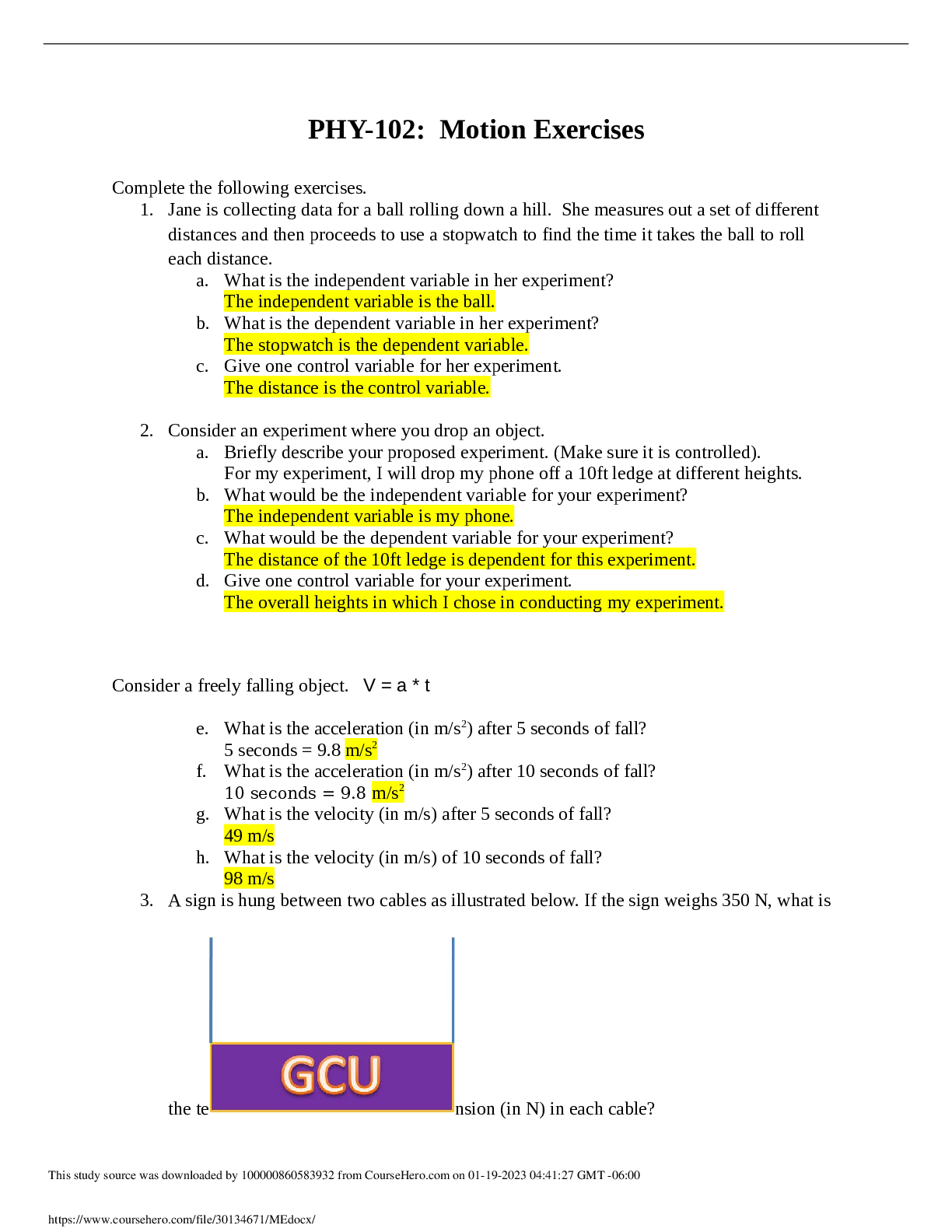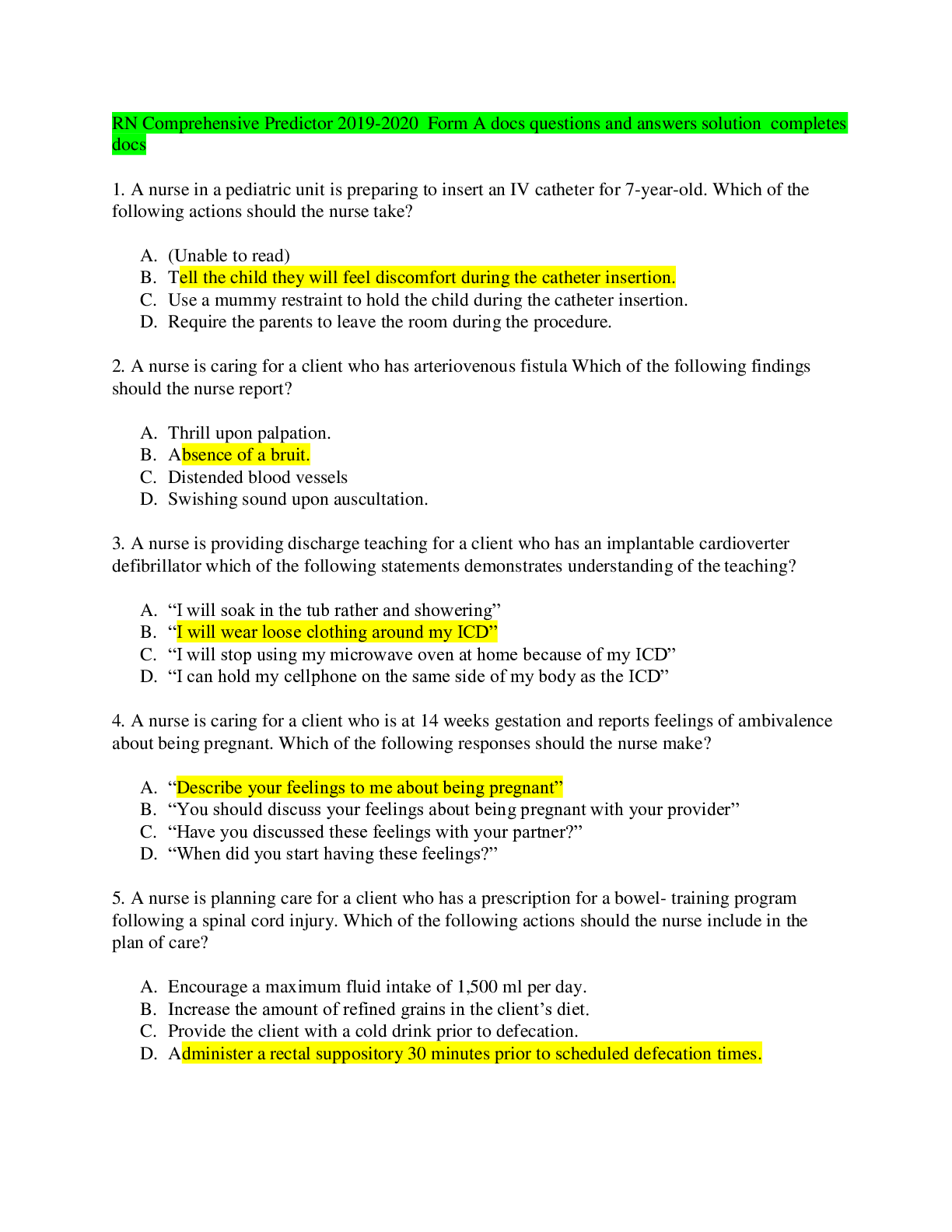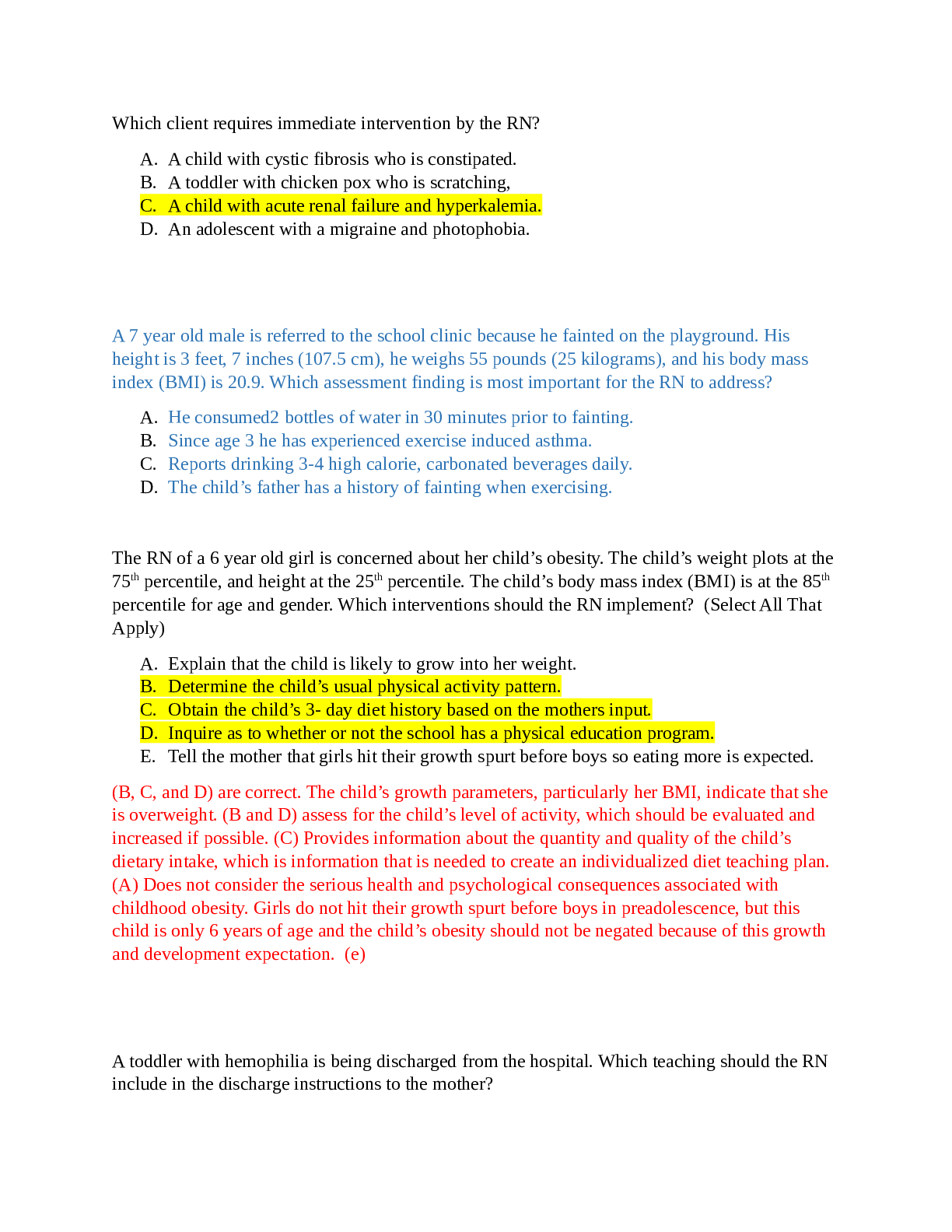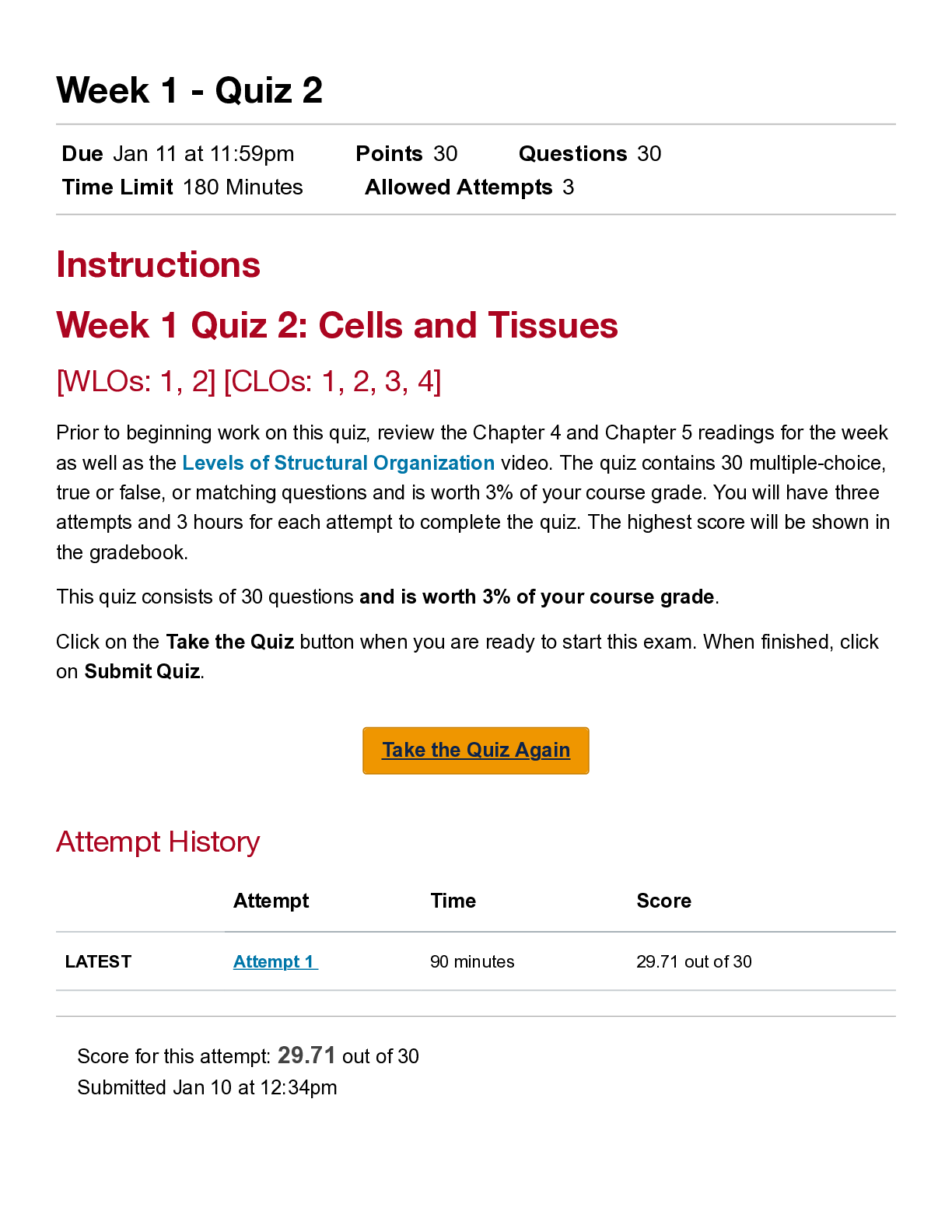E 06 Attempt 1 exam 6 7 creative exp with 100% Questions and Answers
Document Content and Description Below
E 06 Attempt 1 exam 6 7 creative exp with 100% Questions an dAnswers Attempt 1 exam 6 7 creative exp Written: Mar 22, 2020 1:24 PM - Mar 22, 2020 2:41 PM Submission View Your quiz has been submitt... ed successfully. Question 1 2.5 / 2.5 points One purpose for using anecdotal records includes: Question options: a) highlighting student attitudes, preferences, judgments, and participation. b) comparing one child's progress with that of the typically developing child. c) demonstrating emerging understanding of creativity and the arts. d) providing evidence of the learning that was achieved through the course of a major project. Question 2 2.5 / 2.5 points One of the most valuable assessment tools available to teachers is/are: Question options: a) a standardized test. b) a teacher made test. c) formal testing methods. d) observation. Question 3 2.5 / 2.5 points A good observation should include: Question options: a) high inference appraisals of children's behavior. b) terminology that labels the child. c) a detailed description of the context in which the behavior occurred. d) very general information. Question 4 2.5 / 2.5 points In the product-oriented approach to creative assessment, products are evaluated based on: Question options: a) the creativity of student's work. b) practical workability. c) how hard the child worked. d) how closely the product resembles a model. Question 5 0 / 2.5 points Examples of leadership activities that support conceptual leadership include all of the following EXCEPT: Question options: a) writing a position paper on an area of children's creative expression, having it reviewed by experts, and posting it on the web. b) developing an informative flyer that can be shared with the general public about an important area of children's creative expression. c) joining a task force that focuses on children's creative expression. d) making a professional presentation on children's creative expression. Question 6 2.5 / 2.5 points Creativity is an important resource with ________ significance. Question options: a) social b) economic c) cultural d) All of the above Question 7 2.5 / 2.5 points Which of the following supports children's creative thinking? Question options: a) Let's look at these two pictures. b) What did you think of the story? c) What do you predict will happen when…? d) How do you know that is true? Question 8 2.5 / 2.5 points ________ affects creativity. Question options: a) Intelligence b) Motivation c) Learning style d) Emotion Question 9 2.5 / 2.5 points Embracing responsibility for promoting children's creative growth is done by all of the following EXCEPT: Question options: a) keeping interests of children a priority. b) respecting the whole child. c) assessing in unbiased ways. d) preparing children to be masters of factual knowledge. Question 10 2.5 / 2.5 points Assessment of creative thinking and arts-based learning should help teachers to: Question options: a) identify and respond appropriately to the needs of individual children. b) make instructional decisions that benefit the child. c) evaluate program effectiveness. d) All of the above Question 11 2.5 / 2.5 points At a faculty meeting in February, the principal distributes a copy of an editorial that argues that students in the United States are falling far behind students in other countries where creative problem-solving abilities are concerned. One teacher reads the editorial—and even agrees with it—but is unsure about where to start. What would be a recommended way of attending to children's problem-solving abilities in a more focused way? Question options: a) Wait until the next school year to get started because the school year is more than half over. b) Incorporate more group activities into lessons and rely on the students to stimulate one another's creative thinking. c) Put in a formal request for more training in creativity and the arts at the next teacher in-service day. d) Discuss ways to incorporate creative activities into the curriculum during meetings with colleagues who teach at the same grade level. Make a plan to make gradual, steady changes that improve the curriculum and schedule periodic updates on each teacher's progress. Question 12 2.5 / 2.5 points Throughout the school year, a second-grade teacher uses learning centers during science. What is the best way to evaluate student learning during these activities? Question options: a) Observe students during center time to determine if they understand the science concepts. b) Wait until students complete activities and give them a written test afterward. c) Incorporate ways for students to record their observations; for example, a sink/float chart or a record of which items attracted/repelled a magnet. d) Have students write a sentence about what they learned at each center. Question 13 2.5 / 2.5 points Robinson highlights that one of the challenges with creativity is: Question options: a) allowing kids to be creative. b) proving creativity is worthwhile. c) assessing the value of creativity. d) guiding children's creative projects. Question 14 2.5 / 2.5 points All of the following are reasons for conducting assessments EXCEPT to: Question options: a) make instructional decisions. b) identify needs of individual children. c) rank and separate children according to ability. d) improve educational programs. Question 15 2.5 / 2.5 points Which of the following are reasons for assessing divergent/lateral thinking? Question options: a) To determine the impact of an educational program on young children's growth in creative expression and play b) To identify talents c) To provide enrichment and develop potential through special programs d) All of the above Question 16 2.5 / 2.5 points ________involves the process of discovering a child's knowledge, abilities, and interests. Question options: a) Performance assessment b) A teacher made test c) Curriculum d) Standardized testing Question 17 2.5 / 2.5 points Which of the following are considered to be child-centered assessment strategies? Question options: a) Portfolios b) Teacher interviews with students c) Anecdotal records d) All of the above Question 18 2.5 / 2.5 points In the future, it is predicted that workers will need to be: Question options: a) prepared for the industrial era. b) flexible, creative, and capable of functioning in an information society. c) prepared for an agrarian society. d) convergent thinkers. Question 19 2.5 / 2.5 points Studies show that most families make ________ a part of their child's daily experiences. Question options: a) dramatic play b) dance c) painting d) music Question 20 2.5 / 2.5 points All of the following practices support gifted and talented students EXCEPT: Question options: a) pulling children to participate in gifted programs. b) using flexible grouping strategies that respect competency in each subject. c) not forcing children to study material they have mastered. d) recognizing the unique needs of gifted students. Question 21 2.5 / 2.5 points Room arrangement works best when paths are: Question options: a) well defined and clear. b) tight and confined. c) used for other activities. d) placed close to the perimeter of the classroom. Question 22 2.5 / 2.5 points A representative of a parent group affiliated with the school approaches a teacher about making improvements to the playground. She asks for suggestions from the teacher about establishing a creative, safe play environment for students. What are good suggestions the teacher can offer? Question options: a) Remove all the existing equipment and replace the surface with natural materials that provide some cushioning so that wide, open spaces are maximized. b) Gather information on children's preferences and developmentally appropriate play spaces, consider how many children can be accommodated by each piece of equipment, designate areas in which children can engage in different types of outdoor activities, and consider how to make the playground accessible to children with special needs. c) Hire a professional designer to make the playground visually appealing to adults and install as much stationary new equipment as the group can afford. d) Focus on inexpensive equipment (e.g., balls, hula hoops, jump ropes, hopscotch) to get the most for the money spent. Question 23 2.5 / 2.5 points Outdoor storage should have which of the following characteristics? Question options: a) It should be temporary. b) It should be geared to and sized for adults. c) It should be weather-tight to protect items from being damaged. d) Storage is not necessary on the playground. Question 24 2.5 / 2.5 points For materials to enhance the creative environment, they must: Question options: a) suggest only one right answer. b) be inaccessible. c) be difficult to use. d) capture children's attention. Question 25 2.5 / 2.5 points Appropriate materials and equipment for outdoor play should contain: Question options: a) a lot of immovable parts. b) some loose parts. c) large, simple, steel units designed for a single purpose. d) hard, strong surfaces for ground cover. Question 26 2.5 / 2.5 points The major reason for using a planning board is to: Question options: a) help children learn to read. b) keep the room orderly. c) teach children beginning and ending sounds. d) build children's self-sufficiency. Question 27 2.5 / 2.5 points Which of the following theorists and early childhood educators have promoted this concept to the greatest extent when a teacher describe the classroom environment as another “teacher?” Question options: a) Vygotsky and Bandura b) Montessori and Malaguzzi c) Bronfenbrenner and Maslow d) Adler and Skinner Question 28 2.5 / 2.5 points Professional organizations for teachers have a set of standards for establishing high-quality classroom environments. These standards indicate that the classroom environment should support: Question options: a) children's honest expression and thinking, displays of children's work, autonomy for infants and toddlers, and children's feeling of ownership. b) children's feeling of ownership, autonomy for infants and toddlers, displays of children's work, and varied experiences through learning centers. c) assessment of children's work, displays of children's work, children's feeling of ownership, and children's honest expression and thinking. d) displays of children's work, teacher-directed activity centers, children's feeling of ownership, and assessment of children's work. Question 29 2.5 / 2.5 points A teacher scaffolds children’s thinking and relationships with one another. Who would support this classroom practice? Question options: a) Bronfenbrenner b) Montessori c) Malaguzzi and Reggio Emilia Schools d) Vygotsky Question 30 2.5 / 2.5 points The teacher values the interactions of many environments, such as family, school, neighborhood, and peers that are all connected. Who would support this classroom practice? Question options: a) Bronfenbrenner b) Montessori c) Malaguzzi and Reggio Emilia Schools d) Vygotsky Question 31 2.5 / 2.5 points Routines and transitions should NOT be: Question options: a) carefully planned. b) a time for decision-making. c) a learned, consistent activity. d) unsupervised. Question 32 2.5 / 2.5 points A student teacher can't understand why her preschool class has such a hard time moving between center activities and large group activities. She has to raise her voice and remind them several times before they begin to comply. What would be a recommended way to improve this situation for everyone? Question options: a) Discontinue centers and rely on whole group, direct instruction activities only. b) Plan a series of lessons that would teach appropriate behavior and institute a token system to reward the children who behave well. c) Demonstrate and practice concrete ways to transition from one activity to another—a work song to signal clean up, wind chimes to signal a move to centers, or asking children to "freeze" in place to get their attention before giving instructions. d) Assume that the children's parents have allowed this to occur at home and decide that it isn't worth the trouble to try to teach it. Question 33 2.5 / 2.5 points Using carpet and corkboard walls to reduce classroom noise, is an appropriate modification for a student with a(n) ____________ disability. Question options: a) physical b) visual c) auditory d) emotional Question 34 2.5 / 2.5 points Providing easy access to materials is facilitated by: Question options: a) placing materials out of children's reach. b) having clearly marked spaces on shelves. c) assigning children certain times to select materials. d) limiting the amount of materials that can be taken out at one time. Question 35 2.5 / 2.5 points Classrooms that hinder children's creativity are product-oriented and have: Question options: a) teachers who criticize creative thinking. b) children who are absorbed in learning. c) materials that capture and sustain children's interests. d) design features that evoke a warm, homelike quality. Question 36 2.5 / 2.5 points When planning a learning center, which of the following must be considered? Question options: a) Guidelines for meeting standardized testing content b) Teacher interests c) Special needs of children d) The cost of the materials Question 37 2.5 / 2.5 points Providing large spaces in which children can easily move and work is an appropriate modification for a student with a(n) ___________ disability. Question options: a) physical b) visual c) auditory d) emotional Question 38 2.5 / 2.5 points In order to plan and arrange classrooms for creativity and arts-based learning, teachers need to: Question options: a) know the children, and how best to guide their learning. b) provide teacher-directed activities for children's use. c) adhere to a published curriculum guide. d) release all control over the classroom. Question 39 2.5 / 2.5 points Which theorist believes in displaying children’s work to show that children and their work are valued and respected? Question options: a) Bronfenbrenner b) Montessori c) Malaguzzi and Reggio Emilia Schools d) Vygotsky Question 40 2.5 / 2.5 points According to brain research, all of the following emotions are commonly seen in the classroom EXCEPT: Question options: a) joy/pleasure b) fear/threat c) humor/silliness d) sadness/disappointment [Show More]
Last updated: 2 years ago
Preview 1 out of 13 pages

Buy this document to get the full access instantly
Instant Download Access after purchase
Buy NowInstant download
We Accept:

Reviews( 0 )
$9.00
Can't find what you want? Try our AI powered Search
Document information
Connected school, study & course
About the document
Uploaded On
Dec 18, 2020
Number of pages
13
Written in
Additional information
This document has been written for:
Uploaded
Dec 18, 2020
Downloads
0
Views
55

